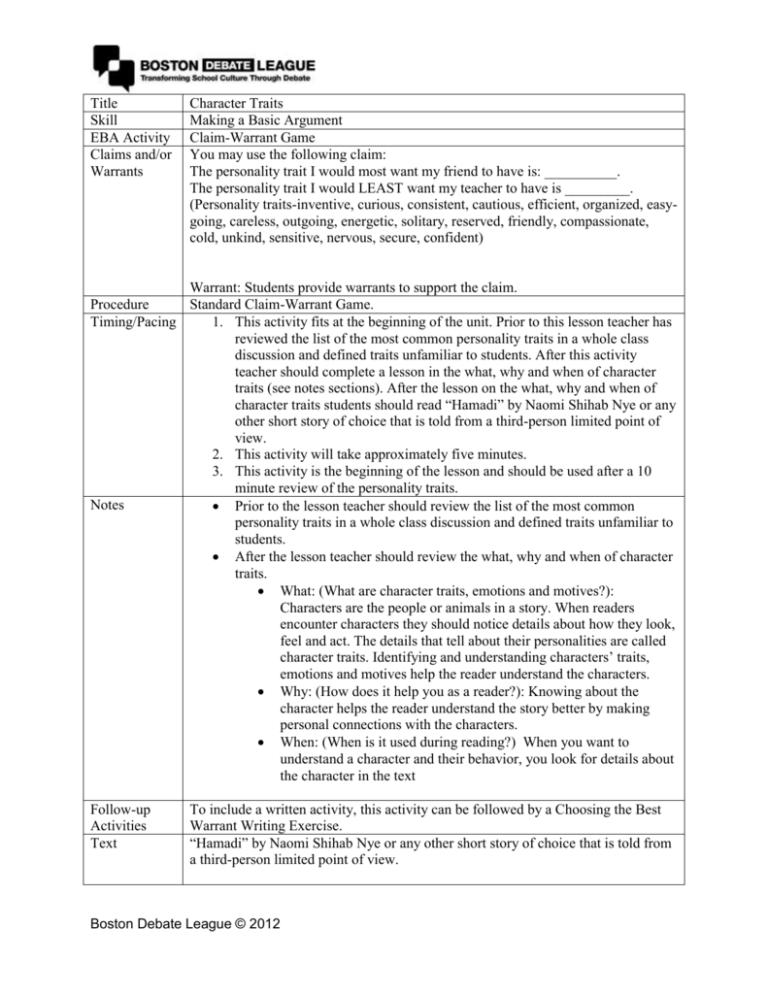Basic Argument Soapbox
advertisement

Title Skill EBA Activity Claims and/or Warrants Character Traits Making a Basic Argument Claim-Warrant Game You may use the following claim: The personality trait I would most want my friend to have is: __________. The personality trait I would LEAST want my teacher to have is _________. (Personality traits-inventive, curious, consistent, cautious, efficient, organized, easygoing, careless, outgoing, energetic, solitary, reserved, friendly, compassionate, cold, unkind, sensitive, nervous, secure, confident) Warrant: Students provide warrants to support the claim. Procedure Standard Claim-Warrant Game. Timing/Pacing 1. This activity fits at the beginning of the unit. Prior to this lesson teacher has reviewed the list of the most common personality traits in a whole class discussion and defined traits unfamiliar to students. After this activity teacher should complete a lesson in the what, why and when of character traits (see notes sections). After the lesson on the what, why and when of character traits students should read “Hamadi” by Naomi Shihab Nye or any other short story of choice that is told from a third-person limited point of view. 2. This activity will take approximately five minutes. 3. This activity is the beginning of the lesson and should be used after a 10 minute review of the personality traits. Notes Prior to the lesson teacher should review the list of the most common personality traits in a whole class discussion and defined traits unfamiliar to students. After the lesson teacher should review the what, why and when of character traits. What: (What are character traits, emotions and motives?): Characters are the people or animals in a story. When readers encounter characters they should notice details about how they look, feel and act. The details that tell about their personalities are called character traits. Identifying and understanding characters’ traits, emotions and motives help the reader understand the characters. Why: (How does it help you as a reader?): Knowing about the character helps the reader understand the story better by making personal connections with the characters. When: (When is it used during reading?) When you want to understand a character and their behavior, you look for details about the character in the text Follow-up Activities Text To include a written activity, this activity can be followed by a Choosing the Best Warrant Writing Exercise. “Hamadi” by Naomi Shihab Nye or any other short story of choice that is told from a third-person limited point of view. Boston Debate League © 2012 Name:_____________________________________ Class: __________ Date:______________ Basic Argument Soapbox Background Information Example Personality Traits: inventive, curious, consistent, cautious, efficient, organized, easy-going, careless, outgoing, energetic, solitary, reserved, friendly, compassionate, cold, unkind, sensitive, nervous, secure, confident Question: A) What is the personality trait you would most want your friend to have? B) What is the personality trait you would LEAST want your teacher to have? 1) Claims (Fill in the blanks to form your answers to the question): A) The personality trait I would most want my friend to have is______________. B) The personality trait I would LEAST want my teacher to have is _______________. 2) Warrant (your reason why your answer is true): A) B) Speech Structure “My claim is ______________________________________________________________________. My warrant for this claim is ______________________________________________________________________.” Boston Debate League © 2012









